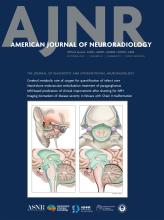This article requires a subscription to view the full text. If you have a subscription you may use the login form below to view the article. Access to this article can also be purchased.
Abstract
BACKGROUND AND PURPOSE: Resting-state functional MRI (rs-fMRI) can be used to estimate functional connectivity (FC) between different brain regions, which may be of value for identifying cognitive impairment in patients with brain tumors. Unfortunately, neither rs-fMRI nor neurocognitive assessments are routinely assessed clinically, mostly due to limitations in examination time and cost. Since DSC perfusion MRI is often used clinically to assess tumor vascularity and similarly uses a gradient-echo-EPI sequence for T2*-sensitivity, we theorized a “pseudo-rs-fMRI” signal could be derived from DSC perfusion to simultaneously quantify FC and perfusion metrics, and these metrics can be used to estimate cognitive impairment in patients with brain tumors.
MATERIALS AND METHODS: Twenty-four consecutive patients with gliomas were enrolled in a prospective study that included DSC perfusion MRI, resting-sate functional MRI (rs-fMRI), and neurocognitive assessment. Voxelwise modeling of contrast bolus dynamics during DSC acquisition was performed and then subtracted from the original signal to generate a residual “pseudo-rs-fMRI” signal. Following the preprocessing of pseudo-rs-fMRI, full rs-fMRI, and a truncated version of the full rs-fMRI (first 100 timepoints) data, the default mode, motor, and language network maps were generated with atlas-based ROIs, Dice scores were calculated for the resting-state network maps from pseudo-rs-fMRI and truncated rs-fMRI using the full rs-fMRI maps as reference. Seed-to-voxel and ROI-to-ROI analyses were performed to assess FC differences between cognitively impaired and nonimpaired patients.
RESULTS: Dice scores for the group-level and patient-level (mean±SD) default mode, motor, and language network maps using pseudo-rs-fMRI were 0.905/0.689 ± 0.118 (group/patient), 0.973/0.730 ± 0.124, and 0.935/0.665 ± 0.142, respectively. There was no significant difference in Dice scores between pseudo-rs-fMRI and the truncated rs-fMRI default mode (P = .97) or language networks (P = .30), but there was a difference in motor networks (P = .02). A multiple logistic regression classifier applied to ROI-to-ROI FC networks using pseudo-rs-fMRI could identify cognitively impaired patients (sensitivity = 84.6%, specificity = 63.6%, receiver operating characteristic area under the curve (AUC) = 0.7762 ± 0.0954 (standard error), P = .0221) and performance was not significantly different from full rs-fMRI predictions (AUC = 0.8881 ± 0.0733 (standard error), P = .0013, P = .29 compared with pseudo-rs-fMRI).
CONCLUSIONS: DSC perfusion MRI-derived pseudo-rs-fMRI data can be used to perform typical rs-fMRI FC analyses that may identify cognitive decline in patients with brain tumors while still simultaneously performing perfusion analyses.
ABBREVIATIONS:
- ASL
- arterial spin-labeling
- AUC
- area under curve
- BOLD
- blood oxygenation level–dependent
- FC
- functional connectivity
- FDR
- false discovery rate
- FWE
- family-wise error
- MNI
- Montreal Neurological Institute
- ROC
- receiver operating characteristic
- rs-fMRI
- resting-state functional MRI
- © 2024 by American Journal of Neuroradiology












